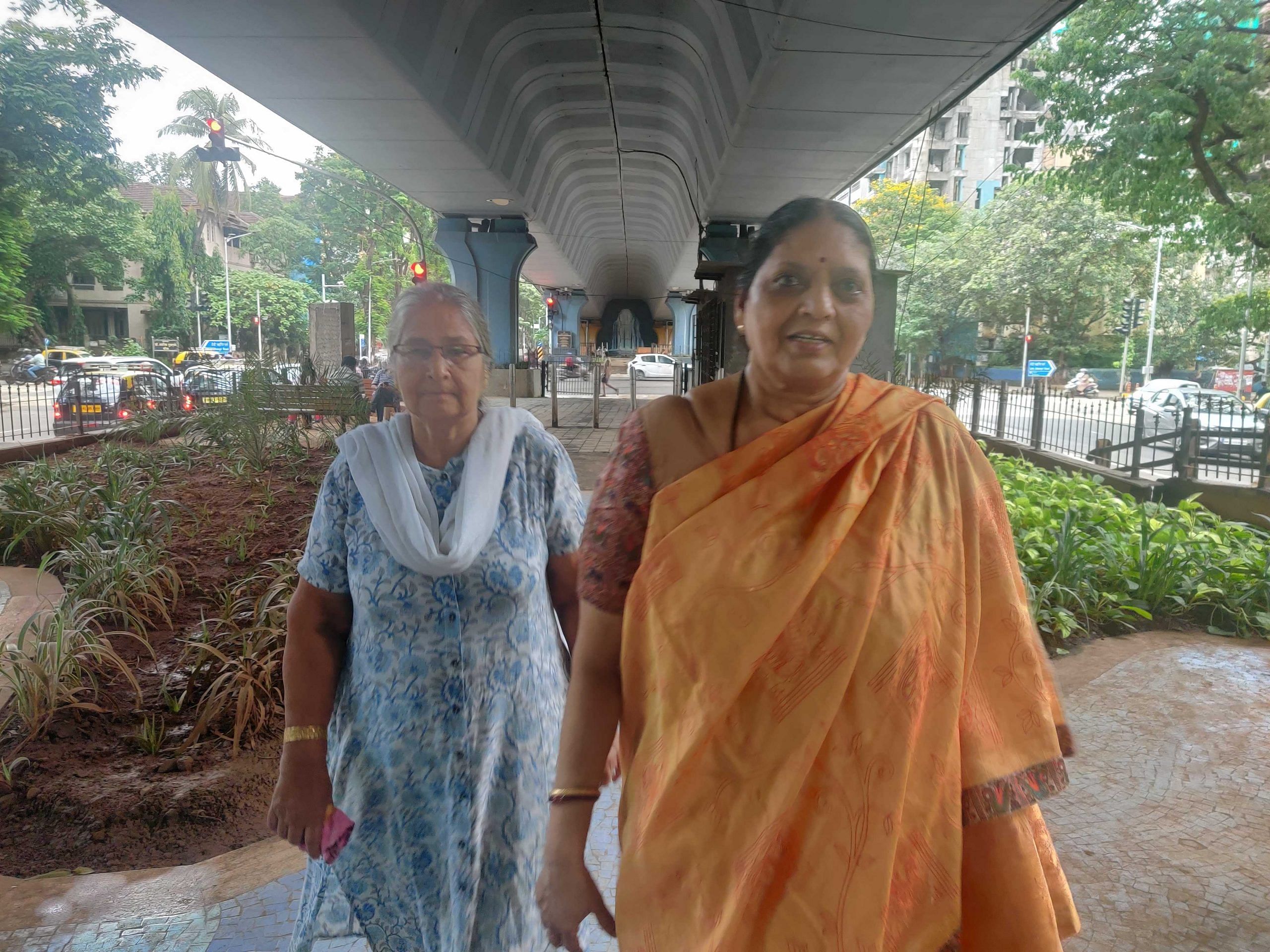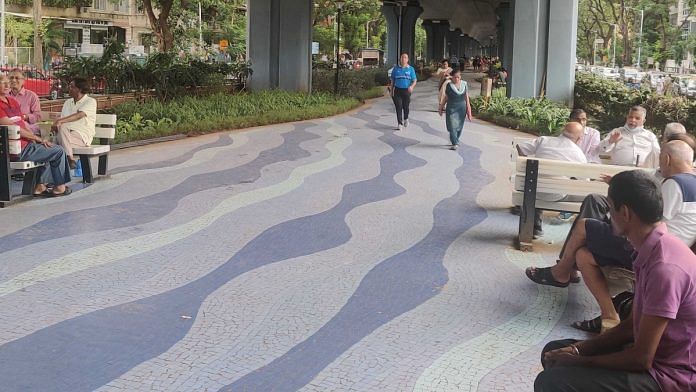It is about 6pm and this neighbourhood Mumbai park is buzzing with life. People stroll, lie down and stretch; older people regale tales and laugh sitting on a bench; women are huddled in a heated discussion and teenagers are playing the guitar and singing. Someone is even managing to read a book quietly.
A lot can happen in a park.
Except that these are miniature parks in India’s maximum city – a unique experiment of building bustling parks under flyovers. The park between King’s Circle junction and Ruia junction, is just 660 meters long and 12 meters wide. In a city infamous for lack of open spaces, the planners are calling it ‘tactical urbanism’ and the BMC has been developing vertical gardens, bus stop greening and many bonsai flyover parks since 2016.
“Anywhere in Mumbai you go, there is traffic and pollution,” says Sunil Kadam, who is in his 40s and lives in the neighbourhood. This is at least safe as we don’t have to walk on footpaths or roads where vehicles come and go all the time.”
The Nanalal D Mehta flyover garden lies between the BMC garden, B N Maheshwari Udyan, and Five Gardens on the other side.
This was the first flyover garden built by the BMC in 2016 with help from residents, the municipal corporation officials say.
“This is part of Tactical Urbanism,” says Kiran Dighavkar, former planning commissioner in BMC who was heading the Tactical Urbanism project up until recently. “Basic theme of tactical urbanism is that major infrastructure projects happen but also leave a lot of unused open spaces. To convert them into community spaces by taking people along, is tactical urbanism.”
There was a problem of encroachment and cars getting parked under those flyovers, recalls Jitendra Pardeshi, superintendent of gardens department at BMC. So we undertook this project of beautification as there was also the need to improve upon the greenery in the city.
“It served a couple of purposes. Greenery in the city would increase, people would get more recreational spaces and even parking encroachments could be avoided. This was important from a security point of view,” says Pardeshi.
BMC officials say the public response to these gardens has been good as they are easily accessible to people staying nearby. Especially for senior citizens who don’t have to go far.
According to an April 2020 report by think tank Observer Research Foundation, Mumbai has an abysmal 1.24 square metres of accessible open space per person compared to London’s 31.68 square metres, New York City’s 26.4 square metres and Tokyo’s 3.96 square metres.
According to Mumbai Development plan 2034, the BMC plans to increase this ratio to 3.37 sq metre per capita.
And tactical urbanism is a part of that exercise.
Also read: Tamil Nadu police has an Idol Wing that’s kinder, gentler and hunts old Bibles, Chola bronzes
Nanalal Mehta flyover garden
As soon as you enter this park, the blue mosaic walkway that resembles the floor of a swimming pool will attract your attention. The park is designed on theme Narmada with information plates dotting the park that describe the river and it’s ghats. The blue walkway gives out the impression of a river with rocks and greenery on its side. The steps resemble a river ghat.
Kalyani Venkatesh and Najma Sheikh, who live in the nearby Matunga, used to visit Five Gardens for their evening walks. But now, Flyover Garden is their choice.
“It is quite safe and clean here. There is a police chowki at the other end,” says Venkatesh. “The road is not uneven. For senior citizens like us, our legs and knees don’t hurt because the road is maintained here unlike near Five Gardens,” says Sheikh.

Sunil Kadam, who has been coming to this park for the last six months, says it is a good place to exercise even during monsoon as the flyover provides some cover. Kadam is not really bothered by the traffic around the park. “Anywhere in Mumbai you go, there is traffic and pollution. This is at least safe as we don’t have to walk on footpaths or roads where vehicles come and go all the time.”
The flyover park is covered with steel fencing and there is ample lighting on the floor. It is open between 8 am and 10 pm. However, during the rains, water seeps through the cracks between the flyover’s two carriageways.
“It’s only during monsoon that it gets messy and muddy, making it difficult to walk,” says Venkatesh.
As the sun was going down, the place started getting filled with evening walkers and strollers. People coming in and going out of the bollard gates.
Pervez Sheikh, a 19-year-old Bachelor’s in Mass Media student at the city’s Khalsa College is sitting with her friend, Divya, chitchatting. Their college is located 500 metres away from the park.
“It is quite safe, and well-lit in the evening. We often come here to study,” says Sheikh. “Reading in the lap of nature is a different experience. This is a good space.”
“Many colleges don’t have good grounds or libraries with enough space. So it is better if you have such gardens nearby,” says Divya.
Pervez and Divya aren’t the only ones. Many college students frequent this park. In a city that lacks quality public spaces, such initiatives are needed, they say.
Also read: Is Shimla story over? Bengaluru-like jams, no water, collapsing buildings, swelling crowds
Space below flyover
Mumbai is one of the densest cities. The elites already have their gated communities that offer open spaces, but the rest, especially those belonging to the lower strata, don’t have that luxury, says Dighavkar.
“This is related to the happiness, and liveability index. More open spaces mean more liveable a city is. So to increase that happiness quotient, more open spaces are needed,” says Dighavkar.
It was the success of the Nanalal D Mehta Flyover Park that inspired BMC to replicate the model in other parts of the city.
Around 20 such flyovers have been beautified by the BMC’s garden department, Pardeshi says. But not all have been developed into parks.
In all, there are about 12 gardens developed. The rest beautified using art work, painting.
Dadar TT flyover and Elphinston flyover, between Flower market and Kamala Mills, are all developed into gardens. While the Goregaon flyover in the suburbs is a vertical garden, a graffiti depicting a library is painted on structures supporting the flyover in Chembur — as if books are put on a shelf.
A minimum of 300 metres of space is requisite to develop such parks under flyovers.
“We look at the requirements of people first and also the space available. We consult the roads and flyover department before going ahead,” says Pardeshi.
“We will also be looking to develop spaces under Metro lines as and when the projects near completion. MSRDC, BMC, MMRDA, all these agencies need to work together to develop them,” says Pardeshi.
On an average, the BMC spends between Rs 1.5-2 crore to develop such spaces.
Being in the heart of traffic, such sparks have their own share of downsides—noise and air pollution. But many Mumbaikars brave the noise to find some greenery, using earphones, cutting them out of the hustle.
(Edited by Anurag Chaubey)






